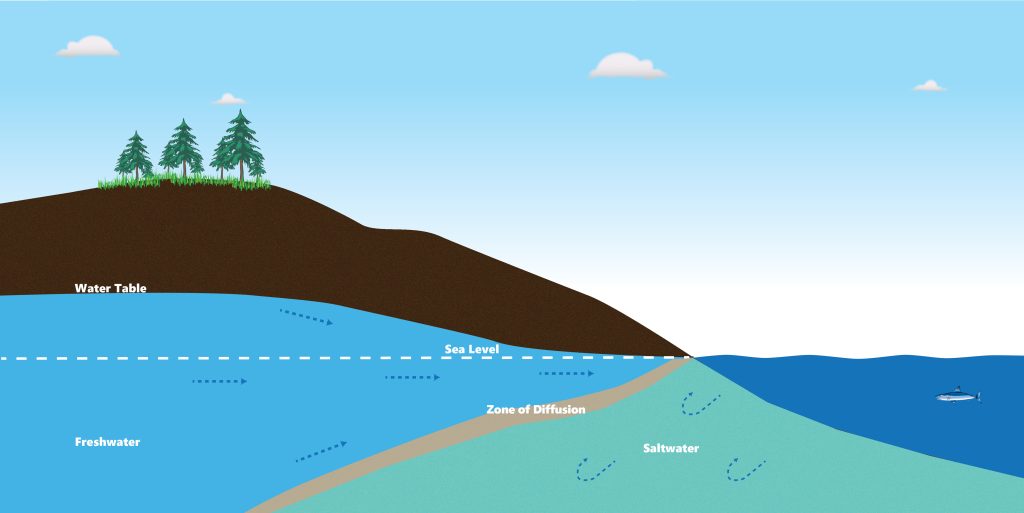The Seametrics CT2X sensor, designed specifically to monitor water quality issues remotely. The CT2X sensor has excellent features to detect and monitor saltwater intrusion in groundwater studies. Here are some of its features:
- Construction – The CT2X is offered in Titanium, which is ideal for operating in salt water. Plus, the pressure sensor is made of Hastelloy as well for corrosion protection of the sensing element. There is an optional anti-fouling kit for the conductivity sensor for areas where biofouling could be a concern.
- Accurate Readings – Seawater is typically around 55,000 µS/cm, depending on the location of course, this can vary. The CT2X 4-pole graphite sensor has a range of 0-300,000 µS/cm, to cover that higher range with an accuracy of plus or minus 0.5% of the measure value below 100,000 µS/cm. Your range needed to study is more than covered.
- Data and Power – Anyone that does long term studies knows the value of time series data and that requires large memory and remote power. The CT2X can operate logging for up to 12 months at 15 min. logging intervals on its own internal, field replaceable Li-Ion AA batteries with a memory of 349,000 records!
- Telemetry System Ready – TheCT2X is ready to network with your telemetry system using RS-485/Modbus or SDI-12 for communication. The CT2X even has a short version, without internal batteries for the expressed purpose of running off auxiliary power, removing the need to change batteries at all.
Seametrics has been producing water quality sensors for over 15 years, and the CT2X is just one of our high-quality products. Let’s take a look on how this Smart Sensor can help with Salt Water intrusions..
Saltwater Intrusion in Groundwater Studies with the CT2X
Fresh water is already a rare resource here on Earth, and it is becoming rarer by the day. One of the biggest contaminants to fresh water sources is salt. The problem is large enough that the need to study saltwater intrusion daily is growing as well. To understand how the CT2X can be used in these studies, we need to first understand the issue of saltwater intrusion and the sources they can come from.
Saltwater Intrusion from Seawater:
Seawater and fresh ground water already interact inland. Under natural circumstances, the interface, called the Zone of Diffusion, remains stable aside from seasonal and weather-related influences. (See Fig. A).

Seawater intrusion is the process of seawater moving into freshwater aquifers due to natural processes or human activities. Seawater intrusion is created by decreasing groundwater levels or by increasing seawater levels. When pumping out fresh water, you lower the height of the freshwater in the aquifer forming what is called a cone of depression. (See Fig. B) The saltwater rises below the freshwater cone of depression and forms a cone of ascension. This saltwater intrusion not only affects the wells actively pumped on, but it can also start to influence wells further inland due to the progression of the cone of ascension. With over 70% of the world’s populations live near a coastline, and many get their drinking water from groundwater sources, as well as a significant amount of agriculture water, this is possibly the biggest source of intrusion, and the biggest concern.

Road Salt:
Use of salt for highways deicing is another source of saltwater contamination. When these deicing salt washes off roads it can easily move with percolating water into underground aquifers and as run off to surface water. Another intrusion source is created by the piles of salt to be used for deicing, which have frequently been stored uncovered along roadways where rain or snowmelt can dissolve the salt and though percolation and runoff, can introduce it into aquifers and other water resources such as reservoirs.
Although the use of road salts is seasonal, the long-term effects on some water resources could be permanent.
Farming:
A growing issue from salt water is its impact on farming, in particular selenium This issue arises when the water used to irrigate one farm picks up salts from natural sources (such as selenium) in the soil. The water runs off the land, it brings the selenium with it. The Salt is transported on the surface to irrigation canals and rivers, and picked up by the next farmer, who in turn uses it and adds a little more. When this continues farm after farm, the salinity level rises to levels where it is no longer a good source for irrigation water and can poison surface water bodies such as lakes and rivers.
Want to learn more about the CT2X, contact us at (800-975-8153) or send us an email at info@seametrics.com
Jassen Savoie– Product Manager – Environmental Sensors
